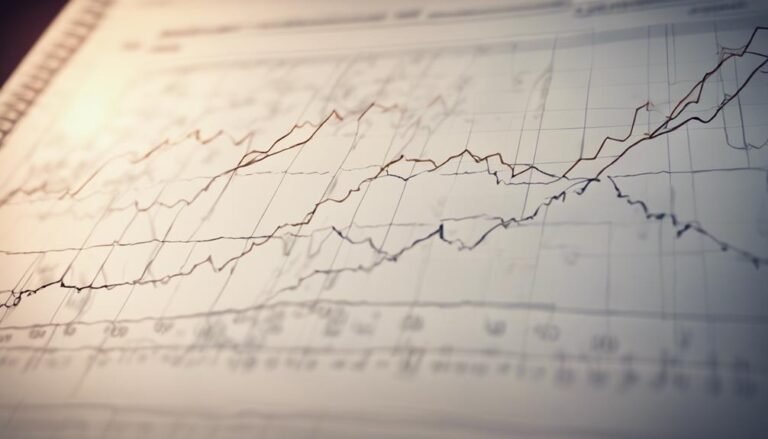Forex Markets: Basics and Strategies for Trading
A solid understanding of economic indicators shapes Forex market sentiment and currency strength. Traders monitor GDP, employment data, and other factors closely. Market sentiment reflects attitudes toward currency pairs, driven by economic reports and geopolitical events. Understanding currency pair dynamics, exchange rate fluctuations, and supply-demand forces is essential for optimizing trading strategies. Key terms like pip, spread, and leverage enhance trading performance. Factors like economic indicators and geopolitical events impact market movements and require strategic adjustments. Technical and fundamental analysis, risk management, and trading psychology play important roles in successful trading. Mastering these elements is key to successfully operating in Forex markets.
Key Takeaways
- Economic indicators impact currency strength and market sentiment.
- Understanding currency pair dynamics is crucial for trade profitability.
- Essential trading vocabulary enhances communication and performance.
- Technical analysis tools like candlestick patterns and trendlines aid in predicting price movements.
- Combining fundamental and technical analysis improves trading decisions.
Understanding Forex Market Fundamentals
To understand the intricacies of the foreign exchange market, it is important to explore the fundamental principles that govern its dynamics. Economic indicators play a pivotal role in shaping market sentiment and influencing currency values. These indicators provide valuable insights into the economic health of a country, affecting the supply and demand of its currency. Key economic indicators include GDP growth rates, employment data, inflation levels, and trade balances. Traders closely monitor these indicators as they can signal potential shifts in a currency's strength or weakness.
Market sentiment, on the other hand, reflects the overall attitude of traders and investors towards a particular currency pair. It is influenced by a wide range of factors, including economic reports, geopolitical events, and central bank policies. Positive market sentiment can lead to increased buying activity, driving up the value of a currency. Conversely, negative sentiment can result in selling pressure, causing a currency to depreciate. Understanding how economic indicators and market sentiment interact is essential for making informed trading decisions in the forex market.
Exploring Currency Pairs and Exchange Rates
Understanding the dynamics of currency pairs and the influence of exchange rates is essential in maneuvering the complexities of the Forex market. Currency pair dynamics involve the relationship between two different currencies and how they interact with each other in trades.
Additionally, fluctuations in exchange rates can have a substantial impact on the profitability of trades, making it vital for traders to stay informed and adapt their strategies accordingly.
Currency Pair Dynamics
Exploring the dynamics of currency pairs and exchange rates provides an essential foundation for understanding the intricacies of forex trading. Currency pair dynamics are heavily influenced by supply and demand forces in the market. When there is high demand for a particular currency pair, its value tends to increase relative to the other currency in the pair. Conversely, increased supply can lead to depreciation.
Understanding these dynamics is critical for traders to anticipate potential market volatility and make informed decisions. Market volatility, characterized by rapid price fluctuations, can present both risks and opportunities for forex traders. By closely monitoring currency pair dynamics and exchange rates, traders can better navigate the complexities of the forex market and optimize their trading strategies.
Impact of Exchange Rates
An in-depth analysis of exchange rates reveals the intricate interplay between currency pairs, shedding light on the significant implications these fluctuations hold for the forex trading landscape. Exchange rates are influenced by various factors, including economic indicators, market sentiment, political events, and global occurrences. Economic indicators, such as GDP growth, employment rates, and inflation, play a vital role in determining the strength of a currency and, consequently, its exchange rate.
Market sentiment, driven by investors' perceptions of economic stability and growth prospects, can swiftly impact exchange rates. Additionally, political events, like elections or geopolitical tensions, and global events, such as natural disasters or pandemics, can trigger significant fluctuations in exchange rates, presenting both risks and opportunities for forex traders to navigate.
Key Terms Every Trader Should Know
Understanding the essential trading vocabulary and common Forex jargon is vital for traders to navigate the complex world of foreign exchange. These key terms serve as the foundation for effective communication and decision-making within the Forex market.
Essential Trading Vocabulary
To navigate the complexities of forex trading effectively, traders must grasp a thorough understanding of essential trading vocabulary, which forms the foundation of successful trading strategies.
Trading psychology plays a pivotal role in how traders interpret market movements and make decisions. It encompasses emotions, behavior, and mindset, affecting trading outcomes.
Risk management is another crucial aspect, involving strategies to minimize potential losses. Traders must be adept at evaluating and mitigating risks through techniques like setting stop-loss orders and position sizing.
Understanding key terms related to trading psychology and risk management is fundamental for traders to develop a structured approach to trading and enhance their overall performance in the forex markets. Mastering this vocabulary can lead to more informed decision-making and improved trading results.
Common Forex Jargon
Understanding the complexities of forex trading demands a thorough understanding of typical forex terminology, which acts as a foundation for traders looking to improve their market knowledge and trading skills. When delving into the world of forex jargon, traders are likely to encounter terms such as:
- Pip: The smallest price move that a given exchange rate can make.
- Spread: The difference between the bid price and the ask price of a currency pair.
- Leverage: The ability to control a large position with a relatively small amount of capital.
These terms are essential for traders to grasp as they navigate the forex markets, helping them make informed decisions and manage their trades effectively while considering aspects like trading psychology and risk management.
Factors Influencing Forex Market Movements
In the dynamic world of forex trading, the movements in the market are greatly influenced by a multitude of factors. Two key factors that play a pivotal role in influencing forex market movements are economic indicators and geopolitical events.
Economic indicators, such as GDP growth rates, employment figures, inflation rates, and interest rates, provide valuable insights into the health of a country's economy. Positive economic data can strengthen a nation's currency as it signals a robust economy, attracting foreign investors. Conversely, negative economic indicators can lead to a depreciation of the currency.
Geopolitical events also have a significant impact on forex markets. Events such as elections, wars, natural disasters, and trade agreements can create volatility and uncertainty in the market, affecting currency values. Traders closely monitor geopolitical developments to anticipate potential market movements and adjust their trading strategies accordingly.
Understanding the interplay between economic indicators and geopolitical events is essential for forex traders to make informed decisions and navigate the complexities of the forex market successfully.
Technical Analysis Strategies for Trading
Analyzing price movements and chart patterns forms the basis of technical analysis strategies for trading in the forex market. When implementing technical analysis, traders focus on various tools and indicators to make informed decisions. Here are three key strategies commonly used:
- Candlestick Patterns: Traders often rely on candlestick patterns to predict future price movements. These patterns provide valuable insights into market sentiment and can help identify potential reversals or continuations in trends.
- Trendlines: Drawing trendlines on price charts helps traders visualize the direction of the market. Trendlines can act as dynamic support or resistance levels, guiding traders on potential entry and exit points for their trades.
- Fibonacci Retracement and Support Resistance: Fibonacci retracement levels and support/resistance zones are essential tools in technical analysis. These levels help traders identify potential price reversal points based on historical price movements and key support/resistance levels.
Fundamental Analysis Techniques for Success
An in-depth understanding of fundamental analysis techniques is essential for achieving success in forex trading. Fundamental analysis involves evaluating economic indicators to determine a currency's intrinsic value. These indicators include GDP growth rates, employment figures, inflation levels, and central bank policies. By analyzing these factors, traders can make informed decisions about the future direction of a currency's value.
Market sentiment also plays a pivotal role in fundamental analysis. This refers to the overall feeling or attitude of traders towards a particular currency. Positive market sentiment can drive up a currency's value, while negative sentiment can lead to depreciation. Traders need to stay informed about geopolitical events, economic data releases, and market news to gauge sentiment accurately.
Successful forex traders combine technical analysis with fundamental analysis to make well-rounded trading decisions. By understanding economic indicators and market sentiment, traders can develop strategies that align with the broader market trends, increasing their chances of success in the forex markets.
Risk Management and Trading Psychology
Effective risk management and a disciplined trading psychology are essential elements for achieving long-term success in the forex market. When it comes to maneuvering the complexities of forex trading, incorporating robust risk management strategies and mastering emotional discipline can make all the difference. Here are three key points to ponder:
- Implementing Risk Management Strategies: Utilize tools such as stop-loss orders, position sizing, and risk-reward ratios to protect your capital and minimize potential losses. By setting clear risk thresholds and adhering to them consistently, you can safeguard your funds against unfavorable market movements.
- Developing Trading Psychology: Cultivate a resilient trading psychology by focusing on mindset mastery and emotional control. Avoid making impulsive decisions driven by fear or greed, and instead, maintain a rational and disciplined approach to trading. Building a strong mental framework can help you deal with the psychological ups and downs inherent in the forex market.
- Maintaining Consistency: Stay committed to your trading plan and avoid deviating from established strategies in response to short-term fluctuations. Consistency in risk management and trading psychology is key to long-term profitability and success in forex trading.
Conclusion
To sum up, mastering the basics and strategies of forex trading is essential for success in the volatile market. Understanding fundamental and technical analysis, as well as risk management and trading psychology, can help traders navigate the complexities of currency trading.
Just as a skilled sailor uses the wind to navigate the seas, a knowledgeable trader uses market fundamentals and strategies to navigate the forex market with confidence and expertise.








